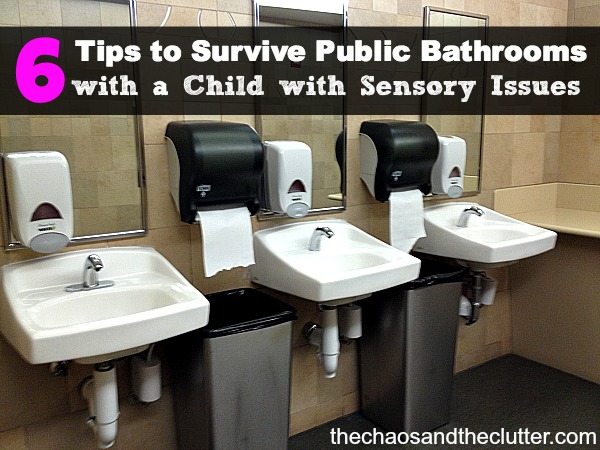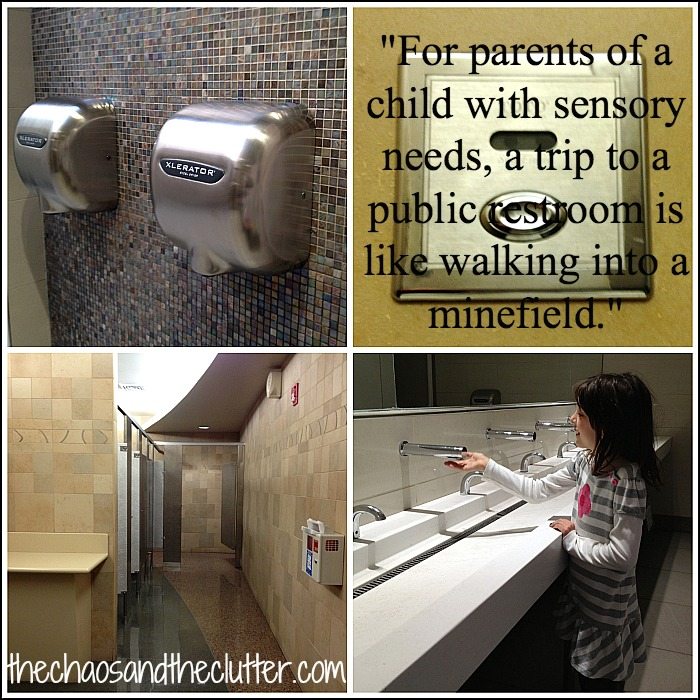For the parents of a child with sensory needs, a trip to a public restroom is like walking into a minefield. The hand dryers that sounds like jet engines, the automatic flush toilets that are equally as loud, the automatic sinks, the paper towel dispensers…can all make for a very difficult experience. I’m guessing that whoever designed these places did not have a child with sensory issues!

For parents of children with SPD (sensory processing disorder) or even kids who just have sensory issues, the fear of those gosh-darn-it-just-plain-awful public toilets are enough to have you avoiding outings altogether.
For children who are sensory avoidant (sensory defensive), these bathrooms are a nightmare. With the loud noises, the strong wind that comes out of the hand dryers that literally moves the skin like some kind of futuristic science experiment, the unexpected surprises thanks to so many things being automated, the potpourri of smells, and the glare of the lights, it’s no wonder for them they can be a very scary place.
For children who are sensory seeking, these bathrooms have the opposite effect. They are like a playground of sensory stimulation with their sights and sounds and smells! In these cases, the trips to the bathroom are more of a nightmare for the parents than for the child.
Lucky me (!), I have kids with both types of issues so those trips to restrooms in malls, airports, restaurants, recreation centres, theatres, grocery stores, museums, and other locations are something I used to dread. Over time, I have gathered some tricks and secrets that have made this less of a challenge for our family.

Here are some tips that I’ve acquired over the years to make these trips to public washrooms a bit more bearable:
Avoid them when possible
This may seem like an obvious solution, but it is a highly effective one. Whenever possible, avoid using the restroom in public buildings. This means not only reminding all of your children to use the washroom before you leave home but also being sure to use it yourself just before leaving. There is no way to ensure that you will never have to use a public restroom, but using the “facilities” at home before going out will at the very least cut back the amount of times you have to face the public ones.
Covering the automatic flush sensor
Carry small stickers or post it notes with you in your purse to cover the automatic flush sensor. This way, your child won’t have to fear the terrible noise going off without warning and can pee in peace!
Familiarity helps
Whenever possible, visit public restrooms that are familiar to you and your child. This will make it easier both because it is familiar and because you can both be better prepared and know what to expect. It’s not always a possibility but if you can always shop at the same grocery store and park near the same entrance to the mall, you can increase the chances that the restrooms will be ones your child is more comfortable with.
Giving them advance warning
Talk to your child ahead of time about what they can expect in a public washroom. Let them know that you will be there with them, supporting them and helping them in any way you can. Encourage them to talk openly with you about which parts you find the most challenging. Address their fears. Brainstorm ideas together for ways to avoid or minimize those challenges.
For sensory seekers, lay out the expectations before you go in. Dayna from Lemon Lime Adventures says that she tells her son that he can only touch things one time. Having expectations such as these laid out beforehand will lessen problems while there. Another suggestion would be for kids to keep their hands in their pockets.
Come prepared
Other than bringing small stickers or post it notes for covering the automatic flush sensors (which are also good for covering the sensors on the taps and hand dryers as well), you can also bring sound dampening earmuffs or noise blocking headphones to keep out the loud and sudden noises that can occur. Even if you are able to cover the sensor on the toilet your child is using, you can’t cover the sensors on the toilets other people are using! Bring hand sanitizer or antibacterial wipes to wash up with so that you can avoid the sink area entirely. This not only allows you to avoid the water, but the powerful dryers as well.
Acknowledge the challenges and give praise
Surviving that minefield is a praise-worthy accomplishment for both you and your kiddo. Acknowledge that you know it wasn’t easy for them and are proud of them for their efforts.
Thankfully, the terror that public washrooms used to hold for my kids is losing its grip as they get older and as they get better skills under their belt for dealing with their sensory needs.
Join me for a free 5 part email series, Little Hearts, Big Worries offering resources and hope for parents.
If you have a child with sensory issues, you may be interested in reading:
Money Saving Sensory Solutions